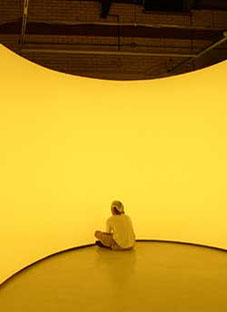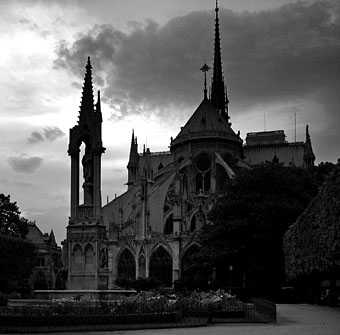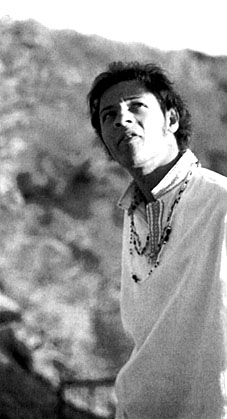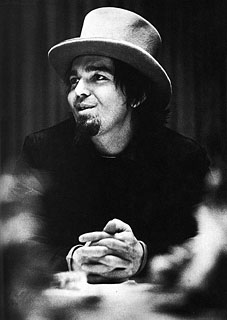The genius of Captain Beefheart
Mission: unlistenable
His music is described as a metal sock, an action painting and a mad, giant watch—yet it has inspired bands from Talking Heads to the White Stripes. John Harris gets to grips with Captain Beefheart
John Harris
Friday August 4, 2006
The Guardian
IN THE 1980s, American researchers found that the average album was played 1.6 times. Given the new practice of impatiently scouring a CD for one or two highlights and then discarding it, the iPod age has presumably seen that figure tumble, but the basic point remains: most of the music we buy lies pretty much unplayed – either because it is rubbish, or because it says a lot more about our vanity than what we actually like. On the latter score, history’s most shining example may be Trout Mask Replica by Captain Beefheart and His Magic Band, an allegedly classic album that must surely sit undisturbed in thousands of households. Playing it—or rather, attempting to—is a bit like being in one of those cartoons in which the principal characters cagily open a door, only to find all hell – elephants, possibly, or a speeding train – breaking loose behind it, whereupon they slam it shut again. Its opening moments let you know what you’re in for: a discordant racket, all biscuit-tin drums and guitars that alternately clang and squall, eventually joined—apparently by accident—by a growling man complaining that he “cannot go back to your land of gloom”. Skipping through the remaining 27 tracks does not throw up anything much more uplifting. Indeed, one song finds the same voice rather distastefully evoking the Holocaust: “Dachau blues, those poor Jews/ Dachau blues, those poor Jews/ One mad man, six million lose.”
When this kind of experience happens to a rock critic, it can easily bring on a chill feeling of inadequacy. After all, Beefheart—those in the know rarely use the “Captain”—remains a gigantic influence on so much rock music that has claimed to stand as something more than mere entertainment, from the post-punk likes of Pere Ubu, Talking Heads, Gang of Four and Public Image Limited, through names as varied as Tom Waits and Happy Mondays, and on to such talents as PJ Harvey, Franz Ferdinand and the White Stripes. Equally importantly, he is a crucial part of the gnomic culture through which those people (men, mostly) whose lives have been hopelessly afflicted by music commune with one another. It’s not in the film, but the Jack Black character in High Fidelity was surely a Beefheart obsessive.
Continues here.
New Olafur Eliasson

left: The Weather Project,
Tate Modern, 2003.
Olafur Eliasson
Ikon, Birmingham
Alfred Hickling
Thursday August 3, 2006
The Guardian
The Danish artist Olafur Eliasson is best known in this country for the Weather Project, which had visitors to Tate Modern’s turbine hall convinced they were staring into the sun. His installation at Ikon, though smaller, similarly leaves you with spots before your eyes.
There has always been a quasi-scientific element to Eliasson’s work: here he teams up with Boris Oicherman of the University of Leeds to conduct an experiment in colour perception. It’s an old saw that the Inuit recognise over 30 different shades of white. But it’s also worth considering that Russians distinguish two different types of blue, while the English language is unique in having a word for pink. Eliasson’s installation is an intriguing demonstration that, as everyone’s retinas are distinct as their thumb-prints, no two people experience the same colour alike.

It begins with a rainbow frieze of coloured blocks demonstrating the spectrum visible to the human eye, painstakingly prepared by master colourists. You next enter a darkened room, where assistants guide you through the experiment. You peer down the eyepiece of an instrument which displays two differently coloured semicircles, and spin a dial until both appear to be a matching shade. It’s reminiscent of the test they made you take at school for colour-blindness; you half expect to be scrutinised by the nit-nurse afterwards.
The final room projects random results against the wall like a large, illuminated piece of op art. Fortunately these are anonymous, as the last thing you wish to have publicised as an art critic is that your colour perception is rubbish. It’s fascinating proof that some people have difficulty distinguishing lemon from lime. But, naturally, I like to believe that my own contribution was spot on.
• Until September 17, 2006.
Ikon Gallery
1 Oozells Square
Brindleyplace
Birmingham
Paris V: Details
Final Paris posting here, gathering up more of the better photos.

Walk down any residential street and you’ll see amazing doors like this that lead to the courtyards of apartment blocks. All the decorations are different, as are the brass door-handles emblazoned with human or animal heads. You could spend months photographing them.
Paris IV: Notre-Dame

Baedeker insists that the façade of Notre-Dame is the cathedral’s finest feature but I disagree; I much preferred seeing the windows on the southern transept and the buttresses supporting the nave. There were also fewer people in the small square at the back. The mass of tourists at the front seemed like a contemporary equivalent of the hordes that have frequently laid siege to the building.
The Cathedral of Notre-Dame, founded in 1163 on the site of a church of the 4th cent. was consecrated in 1182, but the nave was not completed till the 13th century. The building has since been frequently altered, and has been judiciously restored since 1845 ; but the general effect is hardly commensurate with the renown of the edifice. This is owing partly to structural defects, partly to the lowness of its situation, and partly to the absence of spires. It is, moreover, now surrounded by lofty buildings which farther dwarf its dimensions; and, lastly, the adjacent soil has gradually been raised to the level of the pavement of the interior, whereas in 1748 the church was approached by a flight of thirteen steps.
During the Revolution the cathedral was sadly desecrated. A decree was passed in August, 1793, devoting the venerable pile to destruction, but this was afterwards rescinded, and the sculptures only were mutilated. On 10th Nov. in the same year, the church was converted into a ‘Temple of Reason’, and the statue of the Virgin replaced by one of Liberty, while the patriotic hymns of the National Guard were heard instead of the usual sacred music. On a mound thrown up in the choir burned the ‘torch of truth’, over which rose a Greek ‘temple of philosophy’, adorned with busts of Voltaire, Rousseau, and others. The temple contained the enthroned figure of Reason (represented by Maillard, the ballet dancer), who received in state the worship of her votaries. White-robed damsels, holding torches, surrounded the temple, while the side-chapels were devoted to orgies of various kinds. After 12th May, 1794, the church was closed, but in 1802 it was at length re-opened by Napoleon as a place of divine worship.
In 1871 Notre-Dame was again desecrated by the Communards. The treasury was rifled, and the building used as a military depot. When the insurgents were at last compelled to retreat before the victorious troops, they set fire to the church, but fortunately little damage was done.
At the back of the Cathedral is another ‘place’, occupying the site of the old archiepiscopal palace, in the centre of which rises the tasteful Gothic Fontaine Notre-Dame, designed by Vigoureux, and erected in 1845.
At the S.E. end of the Isle de la Cité, not far from the fountain just described, stands the Morgue (open daily), a small building re-erected in 1861, where the bodies of unknown persons who have perished in the river or otherwise are exposed to view. They are placed on marble slabs, kept cool by a constant flow of water, and are exhibited in the clothes in which they were found. The process of refrigeration to which the bodies are subjected makes it possible to keep them here, if necessary, for three months. The bodies brought here number 700-800 annually. The painful scene attracts many spectators, chiefly of the lower orders.
Baedeker’s Paris (1900).


